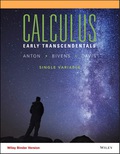
Select between converges or diverges to fill the first blank
Since
Want to see the full answer?
Check out a sample textbook solution
Chapter 9 Solutions
EBK CALCULUS EARLY TRANSCENDENTALS SING
Additional Math Textbook Solutions
Elementary Statistics: Picturing the World (7th Edition)
University Calculus: Early Transcendentals (4th Edition)
Intro Stats, Books a la Carte Edition (5th Edition)
A Problem Solving Approach To Mathematics For Elementary School Teachers (13th Edition)
Calculus: Early Transcendentals (2nd Edition)
Using and Understanding Mathematics: A Quantitative Reasoning Approach (6th Edition)
- Find the limit if the sequence converges and lim sup and lim inf if the sequences diverges (c and d)arrow_forwardDetermine lim an for each sequence (a,) If the limit doesn't exist, explain why. n- 00 4n2 • a. an %3D 2n3 + 5n+1 1+(- 1)" %3D .b.an (- 1)" n3 • C.anarrow_forward00 A student claims that converges because n= lim -15arrow_forward
- Q.2)(A) Determine of each point convergens or diverges: (3) (-2)"(x-3)" √(n+1) M=O MANarrow_forward4. In the Euclidean space R2, give example of a sequence: (i) which is located on the quartic parabola x2 = x1, contains infinitely many different points, and converges to the limit (2, 16) (ii) which includes each of the points (1, 0), (—½, ³), (−½, many times. 2 [10 Marks] ³) infinitely [10 Marks]arrow_forwardhelp pleaearrow_forward
- 1 of 5 (0 complete): Does the sequence (a, converge or diverge? Find the limit if the sequence is convergent. (3n 7)! (3n+4)! Select the correct choice below and, if necessary, fill in the answer box to complete the choice. O A The sequence converges to lim a, %3D (Type an exact answer) B. The sequence divergesarrow_forward5n 3) Determine if the sequence a, = converges or diverges. If it converges, find the limit 2n +1 Show work as demonstrated in class, and make sure to write "converges" or "diverges" as part of your answer.arrow_forward4" Use the ratio test to determine whether converges or diverges. (2n)! n=7 (a) Find the ratio of successive terms. Write your answer as a fully simplified fraction. For n > 7, an+1 lim lim n→00 an (b) Evaluate the limit in the previous part. Enter o as infinity and -o as -infinity. If the limit does not exist, enter DNE. аn+1 lim an (c) By the ratio test, does the series converge, diverge, or is the test inconclusive? Choosearrow_forward
- 4" converges or diverges. Use the ratio test to determine whether (4n)? n=8 (a) Find the ratio of successive terms. Write your answer as a fully simplified fraction. For n 2 8, An+1 lim = lim An n-00 (b) Evaluate the limit in the previous part. Enter oo as infinity and-oo as -infinity. If the limit does not exist, enter DNE. An+1 lim an (c) By the ratio test, does the series converge, diverge, or is the test inconclusive? Choosearrow_forwardmathmatics advancedarrow_forwardFind the limit of the sequence or determine divergence {2n+13-n}arrow_forward
 Calculus: Early TranscendentalsCalculusISBN:9781285741550Author:James StewartPublisher:Cengage Learning
Calculus: Early TranscendentalsCalculusISBN:9781285741550Author:James StewartPublisher:Cengage Learning Thomas' Calculus (14th Edition)CalculusISBN:9780134438986Author:Joel R. Hass, Christopher E. Heil, Maurice D. WeirPublisher:PEARSON
Thomas' Calculus (14th Edition)CalculusISBN:9780134438986Author:Joel R. Hass, Christopher E. Heil, Maurice D. WeirPublisher:PEARSON Calculus: Early Transcendentals (3rd Edition)CalculusISBN:9780134763644Author:William L. Briggs, Lyle Cochran, Bernard Gillett, Eric SchulzPublisher:PEARSON
Calculus: Early Transcendentals (3rd Edition)CalculusISBN:9780134763644Author:William L. Briggs, Lyle Cochran, Bernard Gillett, Eric SchulzPublisher:PEARSON Calculus: Early TranscendentalsCalculusISBN:9781319050740Author:Jon Rogawski, Colin Adams, Robert FranzosaPublisher:W. H. Freeman
Calculus: Early TranscendentalsCalculusISBN:9781319050740Author:Jon Rogawski, Colin Adams, Robert FranzosaPublisher:W. H. Freeman
 Calculus: Early Transcendental FunctionsCalculusISBN:9781337552516Author:Ron Larson, Bruce H. EdwardsPublisher:Cengage Learning
Calculus: Early Transcendental FunctionsCalculusISBN:9781337552516Author:Ron Larson, Bruce H. EdwardsPublisher:Cengage Learning





